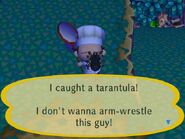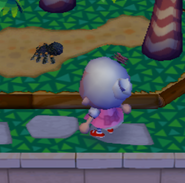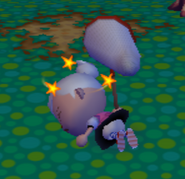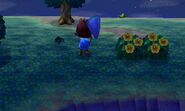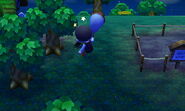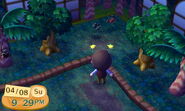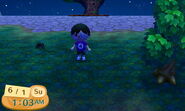- "I caught a tarantula! Don't try this at home!" —Wild World
- "I caught a tarantula! I don't wanna arm-wrestle this guy!" —City Folk
- "I caught a tarantula! WHAAAA! Destroy it!" —New Leaf
The tarantula (タランチュラ Taranchura) is a rare bug found on the ground during summer nights. It is not to be confused with the spider, which is harmless and has different traits. It is more-or-less the twin of the Scorpion. Unlike scorpions, tarantulas can jump over the lower areas of the ramps that separate upper and lower town levels.
Tarantulas are often docile unless agitated. Walking too fast or running while holding a net generally triggers a reaction, as does throwing the net and missing. When docile, tarantulas move slowly, but when agitated they can move almost as quickly as the player when the player is running at their maximum speed. This, in combination with their ability to cut corners, makes them a difficult creature to catch when agitated. Tarantulas in pursuit do not cease chase until they have caught up, fallen in water or the player interrupts the chase with another activity such as digging up a fossil. If the player is bitten by the tarantula, they will pass out and wake up in front of their home.
Villagers are aware of a tarantula's presence and will point it out to a player if it gets too close. (i.e. "Don't make a sound...") If the player is being chased by a tarantula and talks to a villager, that villager becomes paranoid the tarantula is chasing them.
Donating to the Museum
The tarantula can be donated to the Museum, followed by a small, agitated talk by Blathers, the curator.
In Wild World
''Hoo my! It's simply amazing that you were able to catch one of these monsters... Not only is it poisonous, it's as hairy as can be... Blech! Hairy and toxic... Is there any combination more vile?"
The tarantula can be found in the second room of the bug exhibit, in the area where the dung beetle and pill bug are displayed. If donated with the scorpion, the two will engage in battle. However, if just the tarantula is donated, it will follow the player's movements.
In City Folk
"Hoo, such foul fuzziness! And have you seen how fast they move? It's enough to make an owl faint. They're quite docile beasts, and it's documented that they rarely attack people... But when I look at them up close like this, I start to wonder if the experts might be wrong, eh wot?!"
- It can be found in the first enclosure on the middle terrace, which holds the scorpion, centipede, flea and fly to name a few.
The scorpion and tarantula can be seen battling with each other when both have been donated. The scorpion can be seen shaking its stinger at the tarantula, producing a rattling noise. The tarantula can be heard making a hissing-type noise, which might be associated with the arachnid's defense mechanism of scratching hairs at enemies. They will circle each other, and eventually both jump into the air and collide, then begin their battle again. Or, if the player hasn't donated the scorpion, the tarantula will constantly watch the player.
In New Leaf
"Tarantulas are large arachnids that live in warm areas. They're sometimes kept as pets. They have sharp fangs and while it is painful if you're bitten by one, they aren't deadly to humans. What's scarier is the hair they kick off of their abdomens to protect themselves. The hair can cause serious itching and rashes wherever it sticks and can be rather difficult to remove."
The tarantula will wander in its confined area alone. If approached by a player, it will turn around to look at them. However if there is a scorpion donated as well, they will face off in a duel.
Encyclopedia Information
When the player has caught the tarantula, they can find information about the bug in the bug menu. Below is the information regarding the tarantula:
Wild World
- Size: 65 mm.

- Season: Summer.
- Time: Night.
- Their poison isn't potent enough to be lethal, but their belly hair causes itchiness.
City Folk
- Size:65 mm
- Season: Summer
- Time: Night
- The belly hairs these use to fire poison cause more itchiness than the poison itself.
New Leaf
- Season: Summer
- Time: Night
Catching the Tarantula
Tarantulas will attack the player if they walk too fast around it while a net is equipped, or if the player uses the net nearby and misses it. Walking
Catching the tarantula in New Leaf
slowly and capturing it is usually fairly simple, so it is generally advised not to run or even walk at normal speed when searching for them, at least when walking down as visibility is decreased when traveling in this direction. If the tarantula notices a player when they are not holding a net, it will wander away. Equipping a net at this time often initiates an attack as well.
Unlike scorpions, tarantulas can jump. This means that the method of trapping it on the lower level of the town and catching it via the ramp is a bit riskier as it can jump over the shorter regions.
Further Information
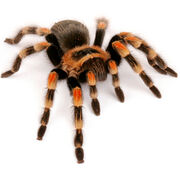
Brachypelma Smithi in real life.
The tarantula in the Animal Crossing series appears to be a Mexican redknee tarantula (Brachypelma smithi), which is a terrestrial species that lives on the ground, often in burrows. The Mexican Red Knee's bite is not nearly as harmful as it is shown to be in the game. In real life, a bite from this particular tarantula is usually no more painful than a bee sting, and certainly will not make a person unconscious. It has an interesting habit of flicking the urticating hairs off of its abdomen in an attempt to irritate predators. Overall, the Mexican redknee is a mostly harmless tarantula, and a very popular pet. It is often used in movies as a prop tarantula because of its docile nature, and intimidating appearance.


